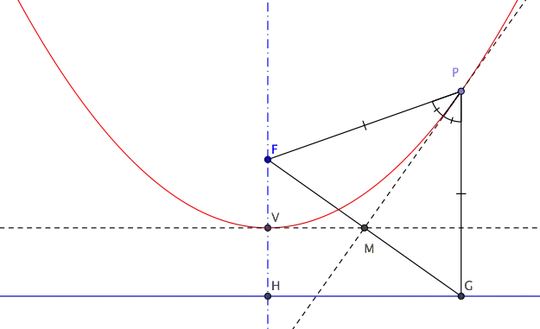If you were to use a standard parabola like $y^2=4ax$, the usual way of representing a point on the parabola is via parametric equations $x=at^2$ and $y=2at$, so the general point is $(at^2, 2at)$.
The gradient of the tangent line to this point is thus $\frac{d(2at)} {dt}$ divided by $\frac{d(at^2)} {dt}$ i.e. $\frac{1}{t}$.
Thus the equation of the tangent line is $y=\frac{x} {t} + constant$ or $constant = ty - x$. We know the tangent line passes through $(at^2,2at)$, so substituting these values for $x$ and $y$ we get $constant= at^2$ and so the equation for our tangent is $$yt - x = at^2$$
The perpendicular through the focus must thus have gradient $-t$ and we know it passes through $(a,0)$. The equation of this line can be written $constant=y+tx$. Substituting $(a,0)$ for $(x,y)$ in this equation gives $constant=at$. Thus $$y+tx=at$$ is the equation of the perpendicular to the tangent through the focus.
Multiply both sides of this last equation by $t$ in order to eliminate terms in $y$ by subtracting the first equation to get $t^2x+x=0$, which can only be true if $x=0$. For $y^2=4ax$, $x=0$ is the equation of the vertex.
